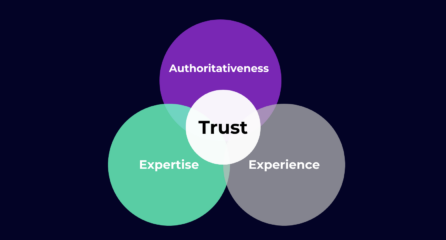Loom made our annual trip to BrightonSEO, and having watched Hannah Smith from Distilled and her ‘Go Big or Go Home’ presentation, it got us thinking about what exactly constitutes ‘big content’, the best ways to start implementing it and how easiest to justify the time you are taking on it.
The constant stream of news that seems to be coming our way as online marketers these days has to signal something – that the time has come to reassess our link-earning strategies, what we are doing to get inbound links and how we are managing our time. Indeed to manage our time effectively, we have to question whether, as an industry, spending hours on end creating sub-standard infographics is really going to cut it moving forward. Why are we doing what we are doing? And how are we going to keep clients and their online marketing strategies moving in the right direction? First, we must go back to basics and completely reassess the way we’re creating content.
What Kind of Content?
What content are you currently producing the most of? Why are you creating that content? Is it because it is easy, does it produce results, or are you targeting a specific market with it? Probably a bit of everything – there is arguably no ‘one size fits all’ type of content marketing, but it is likely that doing a bit of something and a bit of something else won’t serve to benefit yours clients in the same way as ‘big content.’ It won’t engage interest, stimulate or attract your readers in the same way, and a lot of that is down to presentation.
In an increasingly visually aware world, we are essentially attracted to content that looks good. You must have shared, pinned, tweeted or re-blogged stuff just because it’s attractive, well designed or professionally produced. In this instance, the design is the content, and the way it looks the factor which determines how, where and why it’s shared. In other words, we are being told that the upshot is that mediocre content, text based infographics or poorly produced designs are simply not going to be shared compared to what else is being offered.
A good example is this design by Seer Interactive entitled ‘How Do They Make Money’
It is essentially an infographic which has been made interactive. The information need not be ‘big’ or complex – but the way it’s been presented is engaging and looks good. Menus flow seamlessly and it encourages you to keep clicking.
Let’s now look at an interactive infographic which comprises quite a bit more data…
The idea is that you scroll the page by ‘driving’ the car along the page with the arrow keys – coming across new data and info as you go. This type of content is certainly bigger, as it requires a lot of research and time to compile, but again essentially it’s just an infographic with nice typography, good design and an excellent layout. It becomes instantly more shareable.
Research and Planning Big Content
If we are altering our content strategies to create infographics and data visualisations which not only provide interesting information but also look nice and are professionally produced, it’s a good idea to make sure that the information within them is accurate and well researched.
The idea of big content is that not only does it look good; it also provides a stimulating, unique or genuinely interesting take on a well-known issue. Almost anyone can create an infographic based on endlessly seeded material that is widely available – but it takes time to research, investigate and compile data yourself for true big content. It’s worth spending the time to create your own data…you’ll reap the rewards with shares and an increase in linking domains if no one else has seen the information before.
Another benefit of investing in big content with your time is that the rewards have longevity. People return to big content – it not only is ‘evergreen’ but also constantly relevant – it will always be there for people as and when they want to refer to it. Big content, because of the amount of time invested in research, is trusted. It becomes a ‘go to’ resource for the topic in question.
This type of content isn’t just a platform for you to market your ideas on other people – it is also a mechanism whereby you inspire and encourage innovation. Whilst investing time in creating your content, you may stumble across a new way of doing things, a new way of thinking about your marketing strategies or a new way of interacting with your client’s customers. Big content is all inclusive – there is a genuine fascination about the data and information you’ve collated – especially if it answers common problems or helps your audience to do something.
Integrating Big Content without Risk
Big content need not be expensive, but it does take time. Compiling unique and fresh data every time you create a new piece of content requires an investment which arguably means that it is impossible to create big content without a certain degree of risk. There are however ways to lessen that risk and some tips to help you get more out of the time you create content.
- Content that’s bigger, and therefore has more data than your average blog post or infographic, needs to have a story. Plan content with a beginning, middle and end before you start…create a storyboard, sketch your idea out or make a plan of what you want your content to look like. It’ll save you time when putting it together.
- Don’t put all your eggs in one basket. You will actually be losing more time if you create some content which fails to gain any interest or links. If you have a range of ideas on the go at once – even if they’re all in a development stage – you’ll feel less like you’ve wasted time if one of them takes off.
- Use a process. As the image shows below, every element of big content needs to be in place before you’ll reap the rewards. When creating content check these off – it’ll save you time revising or planning something which should have been done at an earlier stage.
There are stages that need to happen in order to create great content – and this is especially important to bear in mind when creating what has been discussed as ‘big content’. If all elements are completed and all stages are complete, you are likely to reap the rewards.
Summary
The end result of the discussions around big content still end up at the same place – it is done to earn links, engage users and social signs pointing towards your brand. The main points involve getting creative – using the aesthetics and presentation of your content to lead and define the data you’re using, making plans and processes to minimise the risk and evolve a strategy of data and research which can help you establish yourself as a trusted voice sharing an interesting or unique take on a particular topic
The world of Big Content has only just begun, but expect to hear a lot more from it in the coming months. If you’d like information about content generation strategies and online marketing, Loom would be happy to help. Call us on 01179232021 or find out about how we work.




